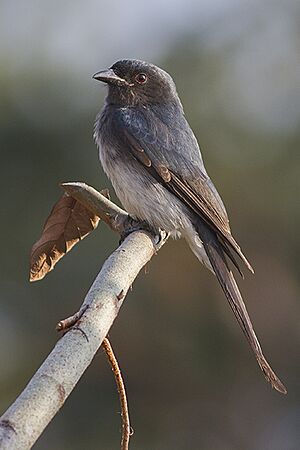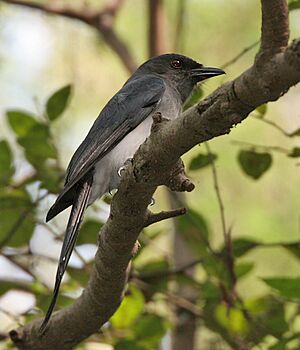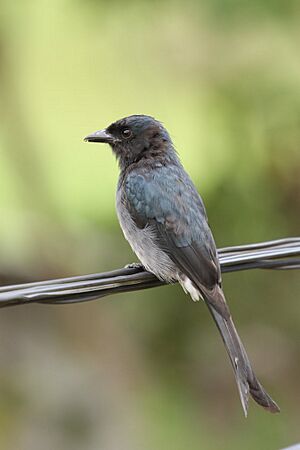White-bellied drongo facts for kids
Quick facts for kids White-bellied drongo |
|
|---|---|
 |
|
| Dicrurus caerulescens caerulescens from Ghatgarh, Uttarakhand, India | |
| Conservation status | |
| Scientific classification | |
| Genus: |
Dicrurus
|
| Species: |
caerulescens
|
| Subspecies | |
|
D. c. caerulescens |
|
| Synonyms | |
|
|
The white-bellied drongo (Dicrurus caerulescens) is a type of bird found in the Indian Subcontinent. These birds are part of the Dicruridae family. They mostly eat insects.
White-bellied drongos are mainly black. But they have a white belly and a white area under their tail. Young drongos are all black. This can make them look like the black drongo. Black drongos are smaller and look more compact. The drongo subspecies in Sri Lanka only have white under their tail.
Contents
About the White-bellied Drongo Name
Scientists give every living thing a special two-part name. This helps everyone know exactly which animal they are talking about. This system is called taxonomy.
In 1747, a naturalist named George Edwards drew and described this bird. He called it "The Fork-tail'd Indian Butcher-Bird." Later, in 1758, a famous Swedish scientist named Carl Linnaeus gave the bird its scientific name, Lanius caerulescens. The word caerulescens means "bluish" in Latin. Today, the white-bellied drongo is in the Dicrurus group. This group was named by Louis Pierre Vieillot in 1816.
There are three main types, or subspecies, of the white-bellied drongo:
- D. c. caerulescens (named by Linnaeus, 1758) – Found from southern Nepal to western and southern India.
- D. c. insularis (named by Sharpe, 1877) – Found in northern Sri Lanka.
- D. c. leucopygialis (named by Blyth, 1846) – Found in southern Sri Lanka.
What Does the White-bellied Drongo Look Like?
This drongo is black on its upper side. It does not have shiny feathers there. Its throat and chest are grey. The belly and the area under the tail are completely white in the Indian type. This type is called the nominate subspecies.
The tail of this drongo is not as deeply forked as the black drongo's tail. You can often see both types of drongos in the same places. Young black drongos can have a lot of white on their underside. But it usually looks scaly.

The Sri Lankan types, insularis and leucopygialis, have white only under their tail. Birds less than one year old do not have white on their underside. They are browner on top and greyish below. Male drongos usually have a slightly shorter tail than females.
Where Do White-bellied Drongos Live?
The white-bellied drongo lives all year round in India and Sri Lanka. You can usually find this bird in dry, bushy areas or open forests. They live in peninsular India, south of the Himalayas. Their range goes west of the Gangetic delta and is bordered by the Aravallis in the west.
Life and Habits of the White-bellied Drongo
These birds are often seen alone or in small groups of up to three. Sometimes, they join groups of different bird species that are looking for food together. They like to sit upright near the tops of trees. From there, they fly out quickly to catch insects in the air. They can even use their claws to catch larger insects.
The song of this drongo has short, sharp notes mixed with clear notes. They can also copy the calls of other birds.
Reproduction and Nesting
The breeding season for white-bellied drongos is from February to July. Their nest looks like a cup. It is similar to the nest of the black drongo. But it is usually made of more twigs and has a good lining of grass. They lay two to four eggs. The eggs are a pale salmon color with reddish spots on the wider end. Nests can be 20 to 30 feet high in a tree fork.
These birds are very protective of their nests. They will attack anything that seems like a threat, even if it is much larger than them. When they are trying to scare away threats, they have been seen copying the alarm calls of squirrels or the sound of a cat. They also join groups of different birds to mob, or scare away, predators.
What Do They Eat?
White-bellied drongos mainly eat insects. But they are also good at finding other food. They have been known to catch small birds. Like other drongos, they use their feet to hold their prey. They sometimes catch insects that are attracted to lights late in the evening. They also visit large flowers like Bombax and Erythrina to drink nectar. They might even help pollinate plants like Helicteres isora.
Images for kids
-
The Indian type of drongo in Sindhrot, Gujarat.






